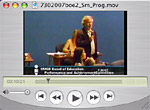
|
Superintendent Art Rainwater gave a presentation on “Value Added Assessment” to the Madison School Board’s Performance & Achievement committee Monday evening. Art described VAA “as a method to track student growth longitudinally over time and to utilize that data to look at how successful we are at all levels of our organization”. MMSD CIO Kurt Kiefer, Ernie Morgan, Mike Christian and Rob Meyer, a senior scientist at WCER presented this information to the committee (there were two others whose names I could not decipher from the audio). |
Related Links:
- Value-Added Research Center at the Wisconsin Center for Education Research – School of Education.
- Wisconsin DPI: Wisconsin’s Longitudinal Data Systems (PPT)
- DPI Data Portal
- More on How States (WI is #1) Inflate Their Progress Under No Child Left Behind“
- 2006 MMSD WKCE Scores: A Closer Look
- More on WKCE Scores – Missing Students
- Madison & Wisconsin Math Data, 8th Grade
- On Wisconsin’s Learning Gap
- Fordham Foundation: Wisconsin DPI Academic Standards = D-
- Wisconsin Math, reading proficiency are much higher on state exams than on federal.
- Bill Herman: Are MMSD Programs Effective? Who Knows:
“That is, there is no way of knowing whether previous WKCE tests were easier or harder than today’s, and also, DPI has changed the curve. For both reasons, we can’t use WKCE to gauge student progress (or lack of it) over time.
Pause and think about this. DPI says WKCE cannot tell us whether the academic skills of Wisconsin students are improving, staying the same, or getting worse over time.”
The fact that the School Board is actually discussing this topic is a positive change from the recent past. One paradox of this initiative is that while the MMSD is apparently collecting more student performance data, some parents (there are some teachers who provide full report cards) are actually receiving less via the report card reduction activities (more here and here). Perhaps the school district’s new parent portal will provide more up to date student data.
A few interesting quotes from the discussion:
45 minutes: Kurt has built a very rich student database over the years (goes back to 1990).
46 Superintendent Art Rainwater: We used to always have the opinion here that if we didn’t invent it, it couldn’t possibly be any good because we’re so smart that we’ve have thought of it before anybody else if it was any good. Hopefully, we’ve begun to understand that there are 15,000 school districts in America and that all of them are doing some things that we can learn from.
47 Art, continued: It’s a shame Ruth (Robarts) isn’t sitting here because a lot of things that Ruth used to ask us to do that we said we just don’t have the tools to do that with I think, over time, this will give us the tools that we need. More from Ruth here and here.
55 Arlene Silveira asked about staff reaction in Milwaukee and Chicago to this type of analysis.
69 Maya asked about how the School Board will use this to determine if this program or that program is working. Maya also asked earlier about the data source for this analysis, whether it is WKCE or NAEP. Kurt responded that they would use WKCE (which, unfortunately seems to change every few years).
71 Lawrie Kobza: This has been one of the most interesting discussions I’ve been at since I’ve been on the school board.
Lawrie, Arlene and Maya look like they will be rather active over the next 8 months.